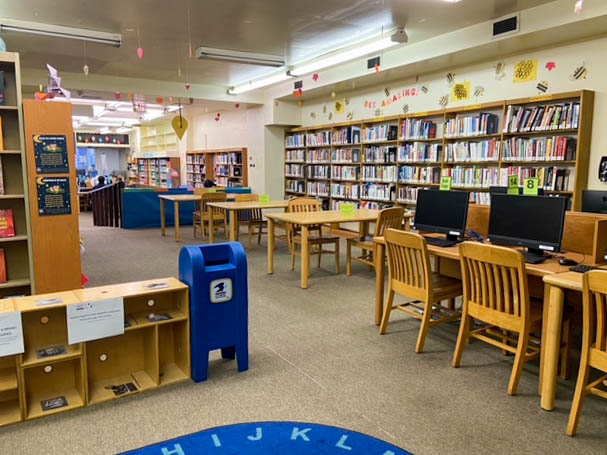Gage Park population: 39,540
Gage Park Public Library current capacity: 25
The Gage Park Public Library was the place where I first found a copy of Assata Shakur’s Assata: An Autobiography in elementary school. I devoured that book. Everything in that book told me that there was more that I needed to learn, that there was more than what I saw before me at the time. It was a door leading to the Chicago struggle for justice.
The Gage Park library has not changed since I was sitting in it two decades ago. It was recently deemed too small to open during the pandemic because it doesn’t allow for social distancing: its floor is the size of two medium-sized rooms, around 550 square feet in total. The library was closed for a year and five months, only reopening on August 2, while other neighborhood libraries had been open for months.
Now, more than ever, the Gage Park community is demanding a library they can use. Students in the area have lost family members to COVID-19. They had to adapt to learning through a computer screen while the adults in their homes were putting in overtime as essential workers during the pandemic. They need access to this key resource, and it is the least that this city could do for one of its most undervalued neighborhoods.
Fortunately, due to the efforts of the Gage Park Latinx Council (GPLXC) and other organizations in the area, this need was brought to light in the context of the pandemic. The library might even provide newer computers and extended hours by the end of the year.
But that’s not enough. And with the leadership of the GPLXC, the community is demanding a new library that is well-resourced and large enough for a neighborhood with a population of more than 39,540 as of 2020.
“A new state-of-the-art public library would show the residents of our community that the city of Chicago and CPL [Chicago Public Library] are committed to investing in our collective futures,” Antonio Santos, executive director of the grassroots organization, said in response to questions over email. “Creating public space for access to information in a resource desert can be a revolutionary act for Gage Park with limitless benefits and potential.”
When I was a child in the late nineties and early 2000s, the library was open seven days a week for the entire day. Inside the library, the six computers were outdated and there was usually a long wait to use one of them, but it offered a place of peace for me. It was dim, which I didn’t mind, but now thinking back, I wonder why a place meant for reading wasn’t brightly lit enough.
The library was already suffering from disinvestment when in 2012 Rahm Emanuel shut down what little access we had to books in that library and sparked outrage in the Gage Park community. His budget cuts included cutting fifty public schools in Black and brown communities and cutting $10 million from the public library budget. All the while, his own children had access to high schools that charged fees as expensive as college tuition and housed state-of-the-art libraries, photography studios, and gymnasiums.
I am not advocating for the removal of these facilities from anyone. I’m merely pointing out the discrepancy between children and communities of privilege and those who are not children of politicians. I want children across my neighborhood in Gage Park to have access to these places even if we are not the children of politicians or the wealthy.
We are worthy of knowing this well-resourced world, where the life of the mind is also an option.
As Santos stated, “The Chicago Public Library claims that there isn’t room in their 100-plus million dollar budget for investment for our community. The task of raising funds for this public project has instead been placed upon the very people who are calling for investment. This means that community members are tasked with the responsibility of raising awareness and funds for a public service that more affluent communities get handed to them.”
Most recently in pushing for a new library, the Gage Park Latinx Council started a petition that has garnered more than 2,600 signatures as of October 11. The neighborhood is in dire need of some good things to happen within its parameters, but that won’t happen unless some resources are first allocated.
So how do we get the library to materialize? Santos has an idea for how the community can push for the library: Gage Park Latinx Council is calling on everyone to contact Chicago Public Library administrators and sign and share a petition to vocalize your support.
You can find the petition for a new public library in Gage Park at bit.ly/gage-park-library-petition.
Gage Park Latinx Council suggests contacting the following Chicago Public Library staff about this issue:
Chris Brown, Commissioner: commissioner@chipublib.org
Mary Ellen Messner, First Deputy Commissioner: mmessner@chipublib.org
Maggie Clemons, Deputy Commissioner, Library Operations and Patron Experience: mclemons@chipublib.org
Maritere Gomez grew up in Gage Park. She has been an activist in the city for over ten years, mostly fighting for immigrant and labor justice for her community that gives so much and is not thanked enough. She is a first-year law student. Maritere last wrote for the Weekly as the Neighborhood Captain for Gage Park in Best of the South Side 2020.



I agree, Gage Park needs a new library. When I read of the new branch library, planned on the campus of the Obama Center, this makes me wonder about our priorities, how we distribute these services. I have frequently ‘worked’ out of Public libraries, utilizing i’net, printers; a free lancer’s access to the free enterprise system. This system should be accessible to all.